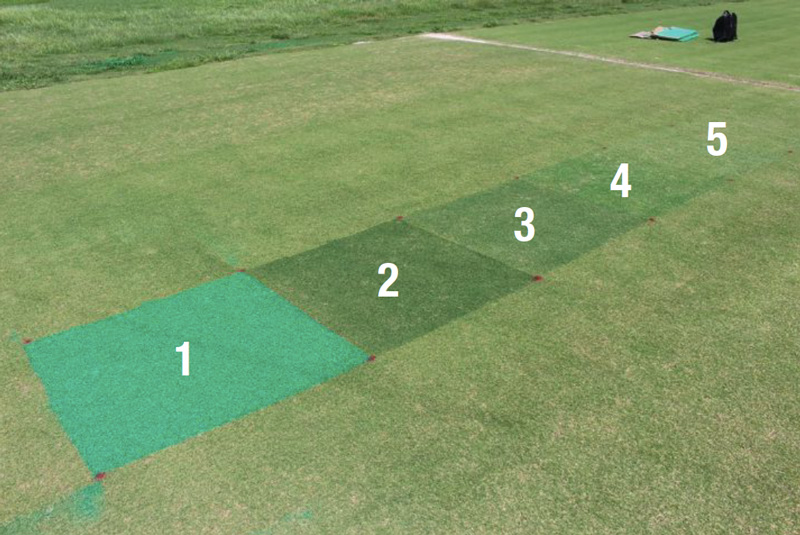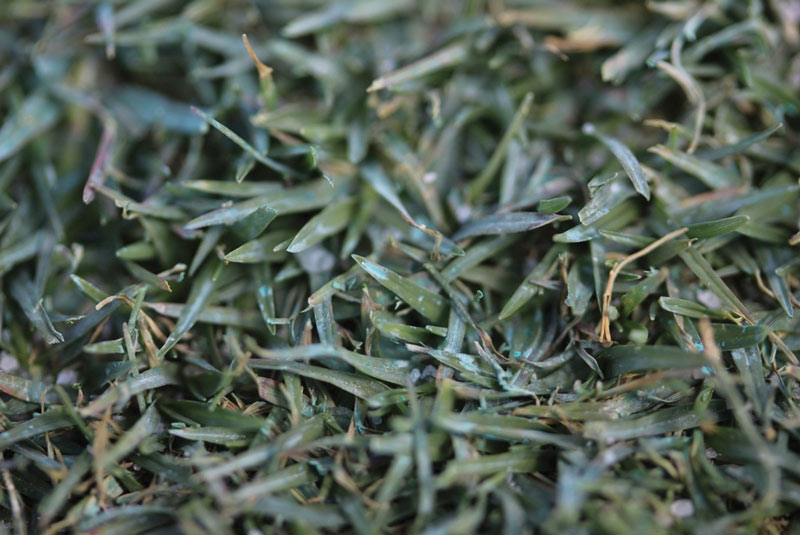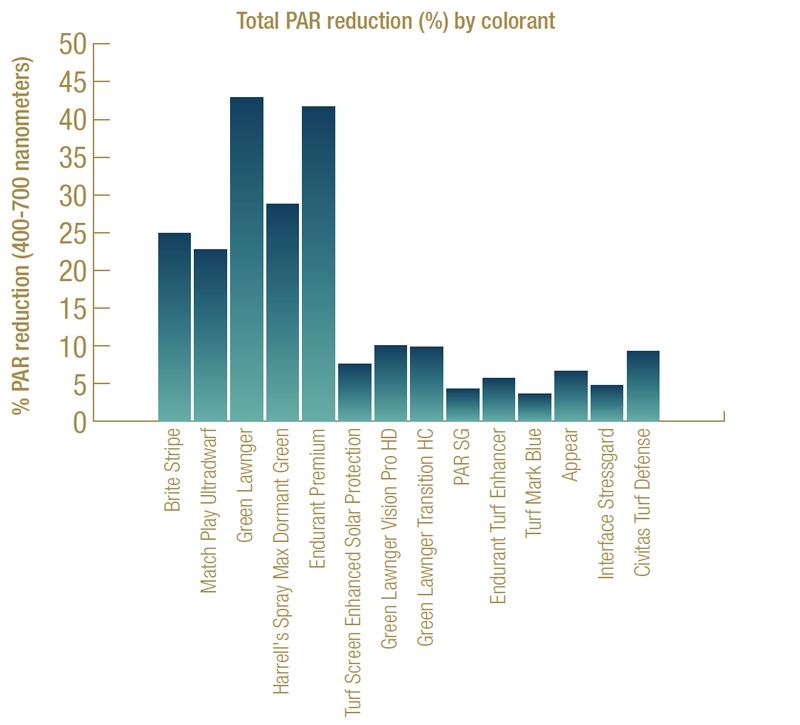
Figure 1. The appearance of early-spring colorant treatment applications to ultradwarf bermudagrass. Left to right: long-term colorants (1, 2); short-term colorants (3); and fungicides with colorants (4, 5). Photos by Casey Reynolds
Editor’s note: This research was funded in part by GCSAA through a grant from the Environmental Institute for Golf.
Turfgrass colorants have become increasingly popular for use on golf course putting greens, tees and fairways in recent years (1). Colorants are commonly used during shoulder seasons, times of the year when turf is not actively growing or is dormant because of suboptimal temperatures, but they are also used as a component of fungicides, tracker dyes and other turf products applied throughout the year.
Although published research on colorants is limited, some of the benefits of colorant applications may include replacing the need to overseed, enhanced color and definition, warmer soil temperatures, and more rapid spring green-up relative to overseeded turf (2). In addition, solar radiation reaching the soil surface has been found to be significantly greater under colorant-treated bermudagrass turf than perennial-ryegrass-overseeded turf during the early spring (3). However, there has been some concern that colorants may also have detrimental effects on plant health if applied during heat stress or if used in excess (3, 4, 5).
Turfgrass colorants can vary significantly in their chemical composition — which is based on their intended use — and in terminology (paints, pigments, dyes, colorants, etc.). Colorant is an overarching term that encompasses anything that provides color, which usually comes from organic or inorganic pigments, depending on the desired color and use. Paints contain pigments along with resin (also called binder) to hold the pigment in place on the leaf surface. They also contain much higher percentages of pigment because they are intended to last longer and provide a more drastic color difference. Paints are commonly used in the end zones and midfields of football stadiums, while colorants are more commonly used on golf courses and contain much less pigment and binder. (Some products used in this research are seen in Figure 1, above.)
Another important point to note is that organic and inorganic pigments in these colorants, with or without binder, are solid particles that retain their structure throughout the application process. Dyes, on the other hand, are organic substances that are fully soluble and do not retain any structure after application.
Although some colorants are suggested to filter the sun’s ultraviolet (UV) radiation, arguably more important are their effects on photosynthetically active radiation (PAR), which is essential for photosynthesis. One concern of superintendents is the potential for colorant applications to excessively shade turfgrass leaves, particularly when the colorants are reapplied to close-cut putting greens during winter and early spring. However, little prior research has quantified the effects of colorants on transmission of sunlight.
Objectives
The objectives of this research were: 1) to examine effects of long-term colorants, short-term colorants and fungicides with colorants on UV radiation (<400 nanometers) and PAR (400 to 700 nanometers) transmission from artificial light sources in the laboratory; and 2) to quantify colorant effects on actual PAR transmission from natural sunlight.
Approach
This research was conducted during April and May 2018 at the Texas A&M Turfgrass Field Laboratory in College Station, Texas. Colorants were selected to represent a combination of available long-term colorants, short-term colorants, and fungicide products containing colorants (Table 1).
Lab evaluation of colorant effects on transmission of UV and PAR wavelengths through solution
Turfgrass colorant solutions were prepared in the laboratory to final water:colorant ratios of 100:1, 250:1, 500:1, 1000:1 and 2000:1. These water:colorant ratios resulted in colorant concentrations of 1%, 0.4%, 0.2%, 0.1% and 0.05%, respectively. Three replications of each concentration were pipetted into 3.5-milliliter quartz cuvettes (standard 1-centimeter [0.39-inch] UV-grade cuvettes). Controls were also prepared that included cuvettes with and without deionized water. Water:colorant samples were then transferred to the laboratory for spectroscopic examination using a PS-300 spectrometer equipped with both halogen and deuterium (SL5-DH UV-VIS) light sources. This setup allowed for measurement of absorption and transmission of both UV and PAR wavelengths. Percent transmission of light was recorded for each turfgrass colorant at each concentration. The procedure was repeated in time to ensure repeatability of data and generate additional data points for this phase of the experiment.
Colorant effects on spectral transmission of PAR wavelengths from natural sunlight
Colorant solutions were prepared at mid-range product and mix volume rates provided on product labels (Table 2). Mixtures were applied to 0.12-inch-thick (3-millimeter-thick) clear acrylic sheets indoors using a handheld boom sprayer with XR 8002 flat-fan nozzles at 40 pounds/square inch (275.79 kilopascals). Desired spray volumes were achieved by calibrating walking speed during applications to a metronome. Three replicate sheets were treated with each colorant. Acrylic sheets were given 24 hours to dry.
Colorant-treated sheets were then placed over the top of an open box that had completely closed sides and an interior painted matte black to reduce reflection/diffusion of transmitted light. A StellarNet spectroradiometer light sensor was positioned in the center of the box 1 inch (2.54 centimeters) below the acrylic sheet. Sunlight transmission through the treated sheets was then measured at solar noon on a cloudless day in late April 2018. For reference, PAR transmission was measured to be ~95% of full sunlight in the absence of colorant (untreated sheets). Colorant effects on spectral transmission properties, as well as overall energy transmitted within 400- to 700-nanometer PAR wavelengths, were then calculated for untreated controls as well as all colorant-applied treatments. The experiment was repeated in May 2018 using new solutions and acrylic sheets.
Editor’s note: How much light is enough light for your turf, and how can you best measure it? Get a rundown of the light requirements of various turfgrasses and a look at handy tools available for measuring light in Measuring light for healthier turf.
Findings
Colorant effects on transmission of PAR and UV wavelengths through solutions in lab
PAR transmission
Among the long-term colorants, percent transmission of 400- to 700-nanometer PAR wavelengths from the artificial light source through solutions in cuvettes was generally very low (Table 1).
Although a range of solution concentrations was prepared, most solutions allowed no transmission at concentrations of 0.1% or above. At the lowest concentration tested (0.05%), Green Lawnger (15.4%) and Endurant Premium (14%) allowed the greatest PAR transmission; of all the long-term colorants, Match Play Ultradwarf (0.05%), Brite Stripe (0.14%) and Harrell’s Spray Max Dormant Green (1.5%) allowed the least transmission. Solution concentrations tested were lower than those actually used in practice, but when extrapolating the data out to actual labeled tank-mixture ratios (colorant:water) — which, with the exception of Brite Stripe, would range from ~5% to 7% solutions — the data suggest that droplets of all products mixed in solution and sprayed in the field allow limited transmission of PAR. In practice, the entire leaf surface is rarely completely covered, but rather, droplets are typically scattered across leaf surfaces, as shown in Figure 2, below. Therefore, only areas of the leaf directly below pigment droplets may experience these reductions in PAR.

Figure 2. A close-up image of colorant-treated ultradwarf bermudagrass putting green turf showing the distribution of colorant mixture applied to the leaf surface.
Short-term colorants also allowed limited amounts of PAR transmission at the 0.05% solution concentration (Table 1). Highest transmission was noted with Turf Mark Blue (29.4%), followed by Endurant Turf Enhancer (3.9%) and PAR SG (2.4%). Of the short-term colorants, Green Lawnger Vision Pro HD (0.5%), Transition HC (0%) and Turf Screen E.S.P. (0%) allowed the least PAR transmission. When extrapolating to label tank-mixture ratios, which ranged from 0.1% to 0.9% based on label recommendations, results were similar to those of the long-term colorants in that no transmission of PAR occurred through the majority of solutions at the label mixture rates. The exception to this was Turf Mark Blue, which was shown to transmit 30% PAR at the labeled mixture ratio of 0.1% solution.
Fungicides with colorants generally allowed the greatest amounts of PAR transmission in cuvette testing. PAR transmission for 0.05% solutions was greatest with Appear (58%), followed by Interface Stressgard (24%) and Civitas Turf Defense (8.5%) (Table 1). Again, when extrapolating data out to label mixture ratios, which range from 0.7% to 5.4%, limited to no transmission would be expected, and in this way, the fungicides with colorants also behave similarly to both long-term and short-term colorants.
UV transmission
All long-term colorants significantly reduced incoming UV radiation (200 to 400 nanometers), as maximum UV transmission only ranged from 0% to 1.4% across long-term colorants (Table 1). Based on these data, at the label mixture volumes, which range from 5.4% to 25%, no transmission of UV radiation would be expected.
Interestingly, although Turf Screen E.S.P. is, to our knowledge, the primary short-term product claiming UV reductions, the majority of short-term colorants we tested excluded virtually 100% of UV radiation across all concentrations. The exception to this was Turf Mark Blue, which allowed 13% UV transmission at the 0.1% mixture rate. It is not known whether the same response would occur at higher concentrations and/or under natural sunlight conditions.
Fungicides with colorants allowed transmission of more UV light than both long- and short-term colorants (Table 1). UV transmission was highest with Appear (37%), followed by Civitas Turf Defense (2.3%) and Interface Stressgard (1.2%). However, as with most other colorants, no UV transmission was detected at label mixture rates for any product.
These results provided unique insights into the comparative transmissivity for both UV and PAR offered by these colorants. In order to extend these results to field situations, additional tests were performed by directly spray-applying colorants onto acrylic sheets at label colorant and mixture application rates followed by measurement of light transmission relative from natural sunlight.
Colorant effects on PAR transmission from natural sunlight
Spectroradiometric measurements of PAR transmission through colorant-sprayed acrylic sheets was carried out as a means of providing a more realistic assessment of colorant effects on plant-available light under field conditions. As noted previously, these applications were made at mid-range rates and carrier volumes specified on product labels (Table 2).

Figure 3. Total PAR (400 to 700 nanometers) reduction (%) relative to natural sunlight produced by long-term and short-term colorants and fungicides with colorants used in the study. All colorants were applied to clear acrylic sheets using the mid-label product application and carrier volume rate. Light measurements were recorded using a StellarNet spectroradiometer at solar noon on a clear day. The data were averaged over repeat studies conducted during May 2018 in College Station, Texas.
Spectral energy distribution curves of PAR transmission indicated differences among long-term colorants (data not shown). Green Lawnger and Endurant Premium showed similar responses in PAR transmission, providing the greatest reductions of the long-term products in blue (400 to 500 nanometers) and red (600 to 700 nanometers) transmission, with relatively less impact on green (500 to 600 nanometers) wavelengths. Match Play Ultradwarf, Brite Stripe and Harrell’s Spray Max Dormant Green allowed noticeably greater transmission of red and blue wavelengths, and their effects on PAR were similar.
Short-term colorants allowed much higher levels of transmission across all PAR wavelengths relative to long-term colorants (data not shown), with the majority of PAR reduction again occurring in the blue and red wavelengths. Overall reductions in blue and red were most substantial with Green Lawnger Transition HC and Green Lawnger Vision Pro HD, with the least reductions seen with Turf Mark Blue and PAR SG.
Fungicides with colorants provided similar PAR reductions to short-term colorants (data not shown). Civitas Turf Defense and Appear led to the greatest blue and red wavelength reductions, while Interface Stressgard had only minimal effects on PAR, primarily in the red wavelengths.
Total PAR energy reductions by colorants
When calculating the effects of colorants on total reduction of PAR (400 to 700 nanometers) energy transmitted through acrylic sheets, reductions of ~20% to 40% were noted with the long-term colorants relative to full sunlight (Figure 2, above). Consistent with the spectral energy curve data, Green Lawnger and Endurant Premium reduced total PAR by the greatest amount (43% and 42% PAR reduction, respectively). Harrell’s Spray Max Dormant Green, Brite Stripe and Match Play Ultradwarf caused the next greatest reductions, which ranged from 25% to 28% of incoming PAR. Short-term colorants and fungicides with colorants caused only minimal reductions in PAR, which ranged from ~5% to 10%.
One drawback to this phase of the study was the inability to quantify effects of colorants on UV transmission as we had done in the laboratory. This was not possible because of the use of acrylic sheets, which naturally filter UV light. While all of the colorants appeared to fully restrict transmission of UV light emanating from a deuterium bulb when measured through spectroscopic methods, natural sunlight conditions may have produced different conditions and possible differences among the colorants.
Conclusions
While traditionally used for color primarily during the shoulder seasons or during winter dormancy, colorants are now receiving more widespread use throughout the season on golf courses. Therefore, it is becoming increasingly important to understand their effects on sunlight, as this could directly impact plant performance in the field.
Based on the findings of this study, a number of differences were apparent between long- and short-term colorants, in terms of both chemical makeup and light transmitting properties. In spectroscopic lab analyses, all colorant solutions fully restricted transmission of both PAR and UV light at their labeled mix concentrations, but differences were apparent at lower concentrations. This phase of the study was designed to assess relative differences among products in a controlled lab environment. As a result, the absolute values of these reductions are unlikely to extend to field situations, but the relative differences among the various colorants remain relevant.
Our study supports this conclusion in that, when a single colorant application was made to acrylic sheets at labeled application rates and sunlight was measured through spectroradiometric methods, long-term colorants caused 20% to 40% reductions in PAR, but short-term colorants led to PAR reductions of only 10% or lower. These observed reductions are consistent with previous research regarding colorant effects on photosynthesis (2, 3, 4) and suggest that caution may need to be exercised when colorants are used repeatedly or under low-light situations.
Funding
This research was made possible through grant funding from GCSAA through the Environmental Institute for Golf and the Lone Star GCSAA Chapter.
The research says ...
- Use of turf colorants (paints, pigments, dyes) — on their own and as a component of fungicides, tracker dyes and other turf products — has become more common on golf courses.
- Colorants can affect plant performance by restricting sunlight.
- In the field, long-term colorants reduced PAR by 20% to 40%, but short-term colorants reduced PAR by only 10% or lower.
- Caution may need to be exercised when colorants are used repeatedly or under low-light situations.
Literature cited
- Briscoe, K., G. Miller and S. Brinton. 2010. Evaluation of green turf colorants as an alternative to overseeding on putting greens. Applied Turfgrass Science 7(1):1-8.
- Hargey, D., B. Wherley, C. Reynolds, R. White and G. Parker. 2016. Performance of winter-overseeded and colorant-treated ‘Tifway’ bermudagrass receiving weekly irrigation and simulated traffic. HortScience 51(5):580-587.
- Hargey, D., C. Reynolds, B. Wherley, R. White and J.
Thomas. 2015. Overseeding and pigment impacts on bermudagrass spring transition. ASA-CSSA-SSSA Annual Meeting Abstracts 418-424.
- McCarty, L.B., J.R. Gann, C.E. Wells, T.F. Bruce and P.D. Gerard. 2013. Physiological responses of creeping bentgrass to pigment-containing products. Agronomy Journal 105(6):1797-1802.
- Reynolds W.C., G.L. Miller and T.W. Rufty. 2012. Athletic field paint impacts light spectral quality and
turfgrass photosynthesis. Crop Science 52(5): 2375- 2384.
Ben Wherley is an associate professor of turfgrass ecology at Texas A&M University, College Station, Texas; Manuel Chavarria is a research scientist at the Prairie Turfgrass Research Centre, Olds College, Olds, Alberta; and Casey Reynolds is executive director of Turfgrass Producers International.